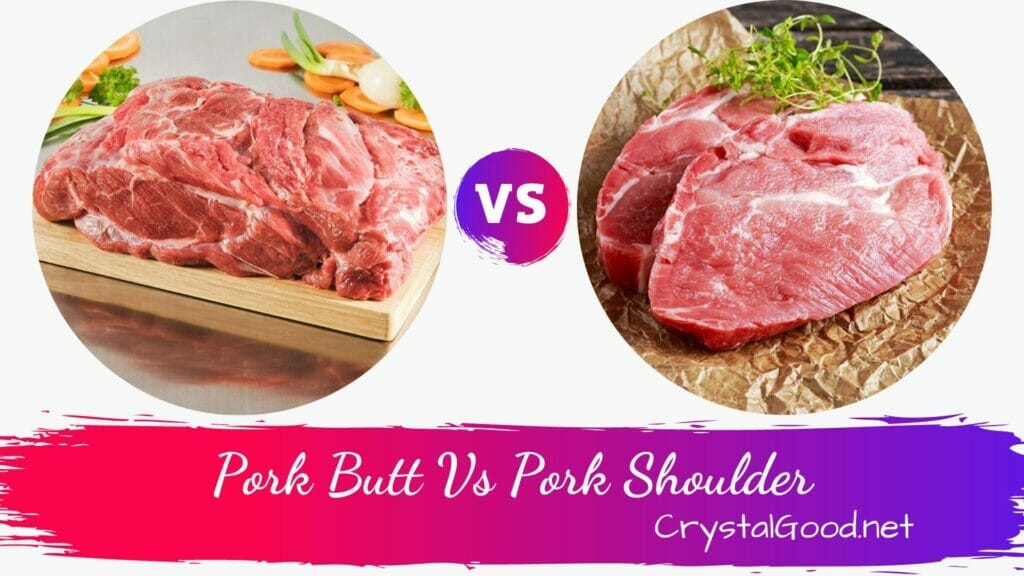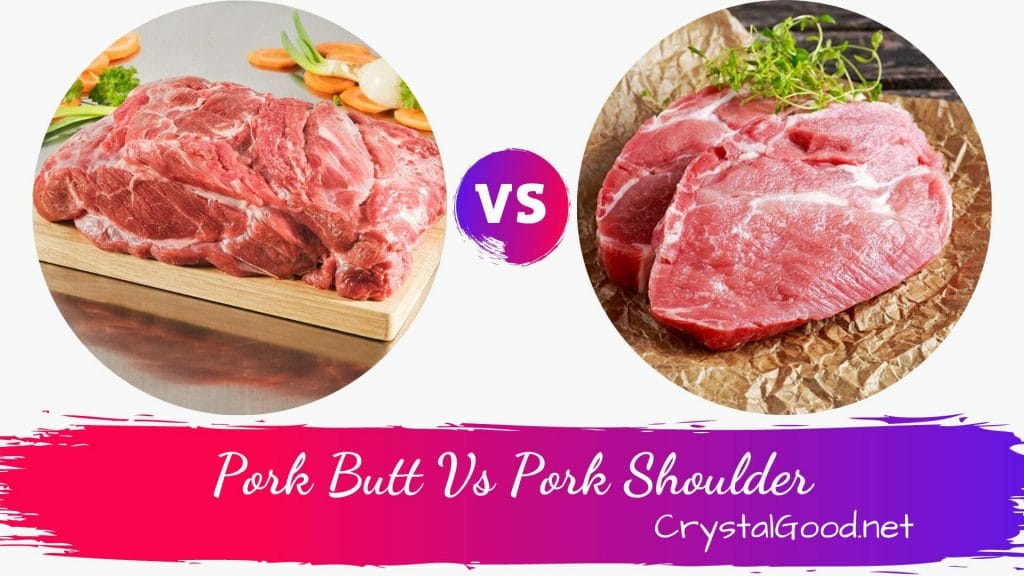For many people, pork is one of their favorite types of meat to cook with. Whether it’s succulent ribs or juicy poached tenderloin, the options are nearly endless and almost always delicious. But when it comes to barbeques and slow-cooked dishes, there seems to be quite a bit of confusion over what cuts of meat should be used. Two such cuts are the ever-popular pork butt and the underrated but flavorful pork shoulder – so let’s take some time today to understand the differences between them!

What Is Pork Butt?
Contents
Pork butt is a cut of meat that comes from the shoulder area of a pig. It is a popular cut of pork that can be cooked in various ways.
It is also known as Boston butt because of its origins. This cut of pork is often used to make pulled pork.
A typical bone-in pork butt weighs between 6 and 10 pounds. This cut of pork is considered a cheaper per-pound option compared to other cuts of pork.
As with any other cut of pork, pork butt is a good source of protein. It is also a good source of B vitamins and selenium. However, it is also high in fat. It is important to consider the amount of calories that you consume when deciding whether or not to include pork butt in your diet.
Pork Butt Nutrition Fact:
Pork is a meat that has long been associated with health benefits. While it is high in protein, it is also rich in a variety of vitamins and minerals that provide antioxidant effects and help with immune function and skin care.
It also contains a fair amount of sodium, but this isn’t the highest on your list of concerns if you’re looking to control blood pressure and avoid heart disease. It only contains 51 milligrams of salt in a 3-ounce serving, which is not enough to raise your daily dietary intake beyond the recommended levels for healthy adults.
One of the key nutritional factors in pork is thiamine, a B vitamin that helps with energy metabolism and cellular growth. It’s also a good source of selenium and zinc. These vitamins and minerals are vital for maintaining good overall health and warding off common illnesses. They help with wound healing, immunity, cell growth and oxidative stress.
What Is Pork Shoulder?
When butchers break down a pig carcass, they first separate the front shoulders into large portions known as primal cuts. These primal cuts are then split into two sub-primal cuts: pork butt and pork shoulder.
Pork shoulder and pork butt are both fatty cuts that can be cooked low and slow to produce tender, moist meat. This makes them perfect for using in recipes like pulled pork or shredded meat.
A pork shoulder is a cut from the top portion of a pig’s shoulder, closest to the spine. It’s a rectangular, uniform shape that can be sold bone-in or boneless.
Traditionally, pork shoulder was sold with the skin still on and is used to make a variety of roasts. However, many butchers are now selling the meat with the skin removed for easier cooking.
Despite its name, Boston butt is actually the cut from the upper part of the shoulder primal above the standard picnic shoulder (sometimes called the “Picnic Ham”). It’s a well marbled cut with intramuscular fat that’s good for braising and slow roasting.
Pork Shoulder Nutrition Fact:
Pork shoulder is an excellent source of animal protein, containing 17.4 grams or 35 percent of the recommended daily value (DV) in a 100 gram-portion. It’s also a good source of vitamins and minerals.
It’s a significant source of the B vitamins thiamin, riboflavin, niacin and B6. These nutrients help the body metabolize fat and carbohydrates for energy.
In addition, pork shoulder is rich in selenium and zinc. A 100-gram portion of raw pork shoulder supplies 26.2 micrograms or 37 percent of the DV for selenium, 3.1 milligrams or 21 percent of the DV for zinc and 190 milligrams or 19 percent of the DV for phosphorus.
Pork shoulder is also a significant source of potassium, magnesium and iron. A 100-gram-portion supplies a whopping 3.4 grams of potassium, 24.2 micrograms of magnesium and 3.5 milligrams of iron.
Difference Between Pork Butt Vs Pork Shoulder:
When it comes to choosing cuts of meat, it’s important to know the difference between pork butt and pork shoulder. Both cuts come from similar primal cuts on the pig, but they behave differently when cooked.
One of the main differences between the two is their fat content. Pork butt has a lot more intramuscular fat, which yields softer and more tender meat.
The fat also helps to keep the meat moist and juicy during slow cooking methods such as smoking or braising. This makes it a great cut for barbecue pulled pork, but if you’re planning on using this cut for other recipes, make sure to cook it for a long period of time.
On the other hand, pork shoulder is a dense and tough piece of meat that lacks much marbling. This is because it’s a well-used muscle on the pig, and so it contains a high muscle-to-fat ratio.
Which Is Better for Cooking?
Pork butt and pork shoulder are both popular cuts of meat that can be used for a variety of dishes. However, these two cuts have very different tastes and textures, making it important to understand their differences before buying them for your kitchen.
Pork shoulder comes from a more active area of the pig’s shoulders than pork butt, which means it has less fat and more connective tissue. This is why it’s a great option for slow cooking methods such as braising and stewing.
But, pork butt also has a lot of fat content and is marbled with intramuscular fat. This makes it an ideal cut for cooking with a lot of flavor.
Butt can be cooked in a number of ways, including grilling or roasting. It can also be smoked to make pulled pork. It’s also a good choice for shredded pork dishes that can be served on sandwiches or in tacos.
How to Store Pork Butt Vs Pork Shoulder?
If you’re trying to decide which cut of pork to buy, it’s important to understand the difference between pork butt and pork shoulder. Choosing the right cut is essential to making your recipes delicious and satisfying.
Both cuts of pork have many nutritional benefits, but they also differ in fat content, marbling, shape, and cooking methods. They both can be used in a variety of recipes, but you should choose the one that suits your taste and cooking preferences best.
Pork butt is typically more tender than pork shoulder, as it has softer muscles and contains more fat marbling. This makes it a versatile cut that works well for pulled pork and as shredded meat in tacos or ramen.
It also requires low and slow cooking to tenderize and make the skin crispy. You can also use this meat for sausage making and meat grinding. However, you should store it properly for food safety purposes, and only cook it when you’re sure the meat is still fresh.
Conclusion:
When it comes to choosing the right cut of meat for your next dish, a little knowledge goes a long way. Two of the most popular cuts are pork shoulder and pork butt. Both are lauded for their quality and versatility. Getting the right piece of meat for your dinner plate can mean the difference between a disappointing meal or a scrumptious smorgasbord. Luckily, there is plenty of information available on the internet to help you make the right choice.
Using a butcher to help you choose the right cut of meat can be intimidating, so it is important to know a thing or two about pork if you want to get the most out of your meal. In particular, you should be able to distinguish pork from its less expensive cousins, like beef and chicken. In addition to identifying the proper cut of meat, you should also be aware of the various cooking methods available for each type of meat. Some of the more popular methods include grilling, boiling, and slow-cooking.













